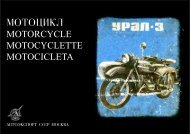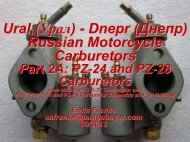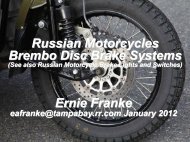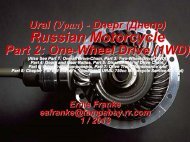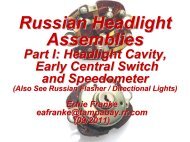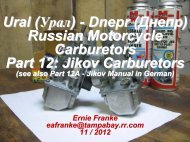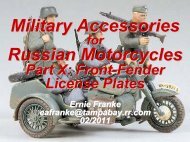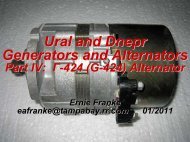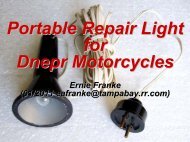Part 1: Introduction - Good Karma Productions
Part 1: Introduction - Good Karma Productions
Part 1: Introduction - Good Karma Productions
Create successful ePaper yourself
Turn your PDF publications into a flip-book with our unique Google optimized e-Paper software.
Ural (Урал(<br />
Урал) - Dnepr (Днепр(<br />
Днепр)<br />
Russian Motorcycle<br />
Carburetors<br />
<strong>Part</strong> 1: <strong>Introduction</strong>-<br />
Carburetor (Карбюраторыъ(<br />
Карбюраторыъ)<br />
Evolution for Russian Sidecars<br />
Ernie Franke<br />
eafranke@tampabay.rr.com<br />
03/2011
Russian Carburetor Contents<br />
• Collection of History, Ideas, Experiences & Current<br />
Offerings, Gleaned Off Internet Websites<br />
• Collected from Forums, Websites (Mostly Russian) and<br />
<strong>Part</strong> Suppliers<br />
• Review of Carburetor Trouble-Shooting<br />
• Review of Carburetor Terms<br />
• Organized by Carburetor Evolution<br />
• Displays Progression (improvements) and Compatibility<br />
(mounting and control cable)<br />
• Multiple Assembly Views for Easy Understanding<br />
• With Advent of the Internet, and eBay On-line Marketing;<br />
Replacement <strong>Part</strong>s and Re-Build Kits Are Readily Available<br />
Although the basis of carburetor designs use<br />
the same principles,carburetors of different models<br />
have their own characteristic features that<br />
define methods of disassembly and assembly,<br />
troubleshooting, adjustment.
Carburetor Evolution<br />
• First We Trace the Evolution of the Ural & Dnepr<br />
Motorcycle Sidecar History<br />
• We Then Establish a Time-Line for Carb Development<br />
• Next We Display Enough Photos of Carburetors that the<br />
Operator Can Clearly Identify Their Carburetor<br />
• We Compare the Performance of Russian Carburetors<br />
• We Look at the Many Sources for Re-Building or Repairing<br />
Russian Carburetors<br />
• We Also Look at the Price of Replacing or Repairing<br />
Russian Carburetors<br />
We have included ample photos, assembly drawings and<br />
line drawings to help identify the correct carburetor<br />
on each Ural / Dnepr. Identification of the carburetor,<br />
along with the electrical system and engine displacement,<br />
helps the operator pin-point the year of manufacture<br />
(assuming the motorcycle has not been modified).
Index: Ural / Dnepr Russian Motorcycle Carburetors<br />
• <strong>Part</strong> 1: <strong>Introduction</strong>-Carburetor Evolution for Russian Sidecars<br />
• <strong>Part</strong> 2: K-37 Carburetors<br />
• <strong>Part</strong> 2A: PZ-28 Carburetors<br />
• <strong>Part</strong> 3: K-38 Carburetors<br />
• <strong>Part</strong> 4: K-301 Carburetors<br />
• <strong>Part</strong> 4A: Adjustment and Overhaul of K-301 / K-302 Carbs<br />
• <strong>Part</strong> 5: K-302 Carburetors<br />
• <strong>Part</strong> 6: K-62 Carburetors<br />
• <strong>Part</strong> 7: K-63 Carburetors<br />
• <strong>Part</strong> 7A: Adjustment and Overhaul of Pekar K-63 / K-65 Carbs<br />
• <strong>Part</strong> 8: K-65 Carburetors<br />
• <strong>Part</strong> 9: Kaptex VDC-RAM Carburetors<br />
• <strong>Part</strong> 10: K-68 Carburetors<br />
• <strong>Part</strong> 10A: K-68 Disassembly<br />
• <strong>Part</strong> 10B: K-68Y Carb Manual<br />
• <strong>Part</strong> 10C: Adjustment of K-68 Carb<br />
• <strong>Part</strong> 11: Mikuni Carburetor<br />
• <strong>Part</strong> 11A: VM Mikuni Carb Manual<br />
• <strong>Part</strong> 11B: Re-Jetting Mikuni and Keihin Carbs<br />
• <strong>Part</strong> 12: Jikov Carburetors<br />
• <strong>Part</strong> 13: Keihin Carburetors<br />
• <strong>Part</strong> 13A: CVK32 Carburetor Clinic<br />
• <strong>Part</strong> 13B: Keihin CVK32 Disassembly<br />
• <strong>Part</strong> 14: Carburetor Repair and Re-Build Kits<br />
• <strong>Part</strong> 15: Synchronizing Carburetors<br />
• <strong>Part</strong> 16: Carburetor Flanges and Gaskets<br />
• <strong>Part</strong> 17: Carburetor Enricheners (a.k.a. Chokes)<br />
• <strong>Part</strong> 18: Identification (I.D.) and Comparative Carb Prices ($2011 U.S. Dollars-USD’s)<br />
• <strong>Part</strong> 19: After-Market Carburetor Products<br />
Carburetors for Russian Sidecars are presented as a function<br />
of time as they evolve to provide better service<br />
and meet stringent EPA regulations.
Carburetor Functionality and Trouble-Shooting<br />
• Carburetor Function<br />
– Breaks Fuel into Tiny <strong>Part</strong>icles (vapor)<br />
– Mixes Fuel with Air in Proper Ratio to Burn without Leaving Excess<br />
Fuel or Air<br />
– Delivers Combustible Air-Fuel Mixture to Engine<br />
• Troubleshooting<br />
– When Air-Fuel Mixture Is Too Rich (excess fuel)<br />
• Engine Sounds Dull and Idles Roughly<br />
• Engine Stalls When Enricheners (a.k.a. Chokes) Applied<br />
• Engine Performance Grows Worse as It Warms Up<br />
• Removal of Air Cleaner Improves Engine Performance<br />
• Exhaust Gases Are Sooty<br />
• Spark Plug is Fouled (black wet deposit around electrode)<br />
– When Air-Fuel Mixture Is Too Lean<br />
• Poor Acceleration, Noticeable Lack of Power at Full Throttle<br />
• Improved Performance when Enricheners (a.k.a. Chokes) Closed<br />
• Engine RPM Fluctuates<br />
• Engine Overheats<br />
• Spark Plug Burns (blistered white insulator)<br />
Proper functioning of the carburetor<br />
yields the right proportion of fuel and air to the engine.
Distinctive Components of Russian Carburetors<br />
Enrichener<br />
(a.k.a. Choke)<br />
Butterfly Valve<br />
Throttle<br />
Branch Pipe<br />
Compliant<br />
Flange<br />
Carburetor<br />
An example of identifying distinctive parts of a carburetor is shown s<br />
on a<br />
modern (Keihin(<br />
CVK32) ) with a spigot mount and butterfly valve throttle.
Round-Slide vs. Flat-Slide vs. Butterfly Throttle Valves<br />
• Round-Slide Throttle Valve<br />
–K-37, PZ-28, K-38<br />
–Kaptex VDC-RAM<br />
–K-68<br />
–Mikuni VM-28<br />
–Jikov 2928<br />
• Flat-Slide Throttle Valve<br />
–K-301 / K-302<br />
–K-62 / K-63 / K-65<br />
• Butterfly Throttle Valve<br />
–Keihin CVK32<br />
One term describing carburetors is round-slide,<br />
flat-slide or butterfly throttle valves.
Flange-Mount vs. Spigot-Mount<br />
• Flange-Mount<br />
– Bolts Directly on Cylinder Head or Adapter<br />
– K-37, PZ-28, K-38,<br />
– K-301 / K-302<br />
– K-62 / K-63 / K-65 / K-68<br />
– Kaptex VDC-RAM<br />
• Spigot-Mount<br />
– Rubber Compliant Mount to Cylinder Head<br />
– Mikuni VM-28<br />
– Jikov 2928CE<br />
– Keihin CVK32<br />
Another term describing carburetors is<br />
flange-mount or spigot-mount.
Flange-Mount: Vertical vs. Horizontal<br />
• Vertical Mounting Holes (MT-9's, MT-10's)<br />
– K-37, PZ-28, K-38, K-301, K-302<br />
• Horizontal Mounting Holes (MT-11’s, MT-16’s)<br />
– K-62, K-63, K-65, Kaptex VDC-RAM, K-68<br />
• Transition from Vertical-to-Horizontal<br />
– Used to Transition from Older K-37/38 and K-301/302 Carbs to<br />
Modern K-62 / K-65 / K-68 Carbs<br />
– Adapter Plates Readily Available<br />
An adapter plate is needed to upgrade older motorcycles<br />
to the modern horizontal pattern for the K-63 / K-65 / K-68 type carbs.
Regular Carburetor Periodic Maintenance<br />
•Carburetors Require the Sediment in the Float Bowls Be Drained<br />
Periodically<br />
–Ensures That Any Contaminants Accumulated Do Not Enter the Main<br />
or Idle Jets of the Carburetors<br />
–Fuel Can Be Drained by Opening the Drains Provided on Bottom of<br />
Float Bowls<br />
•Fuel Filters Should Be Changed Every 10,000 km or When They Appear<br />
Dirty or Not Flowing Fuel Correctly<br />
–Changing the Filters Ensures That Clean Fuel Is Provided to the<br />
Carburetors and That There Is No Fuel Starvation<br />
•Carburetor-to-Cylinder Head Adapters Should Be Checked for Leaks and<br />
Cracks Every Trip<br />
–Failure of Adapters Will Cause the Carburetor Fuel Mixture to Become<br />
Lean, which Could Cause Internal Damage to the Engine<br />
Regular maintenance helps prevent the mysterious problems<br />
associated with the carburetor.
Russian Carburetor Time-Line<br />
(03/2011)<br />
K-37 (M-72)<br />
K-37 (M-72, M-72K, M-72M,<br />
M-72H, K-750)<br />
K-38 (M-61, M-62, M-63)<br />
K-301Б (M-63, M-66, K-650/MT-9)<br />
K-301В (MT-10)<br />
K-301Г (M-63, M-67, M-67.36)<br />
K-301Д (MT-10,<br />
MT-10.36, MB-650M,<br />
K-650/MT-8/MT-9)<br />
K-37 K-37A<br />
K-38<br />
K-301<br />
1940 1945 1950 1955<br />
1960<br />
1965<br />
1970<br />
K-63/K-65 (MT-11, MT-16)<br />
CVK32 Keihin<br />
(8.103, 8.107)<br />
K-302 K-62 K-63/K-65<br />
K-68<br />
1975<br />
K-302 (MT-11, MT-12, IMZ-8.103)<br />
K-62 (MT-16, MT-12, MB-650)<br />
28 mm Mikuni (8.103)<br />
K-68 (MB-650)<br />
Urals<br />
Last of the Dneprs<br />
1975 1980 1985 1990<br />
1995<br />
2000 2005<br />
2010<br />
We have seen the gradual migration of the K-37 to the K-37A<br />
and then the K-38. The K-301 went through several iterations<br />
before the K-302 came along, followed by the K-Series carburetors.
K-301 to K-63 K<br />
thru K-68 K<br />
Carburetor Transition<br />
(http://www.cossackmotorcycles.com/dnepr.html)<br />
•Famously Awful K-301 Carburetor<br />
•Standard on MT-9 and MT-10.36 Dneprs<br />
•Standard on M-63 and M-66 Urals<br />
•If They Work, You’re One of the Few Lucky People<br />
•Main Problem: Worn-Out in a Surprising Short Time<br />
•One Solution: Replacement Pair of Re-conditioned K-301’s<br />
•Better Solution: Fit Just about Any Other Carb<br />
K-301<br />
•K-63 / K-65 Series<br />
•Ok, If You Don't Mind Setting and Adjusting Carbs<br />
Every Other Week<br />
•K-65 Will Not Fit Directly on a Bike Which Originally<br />
Had K-301’s. Need Adapter Plate (vert.-to-horiz. mtg)<br />
K63/K65<br />
The common carburetors found on 650cc Russian motorbikes were<br />
the K-301’s and K-302’s. The K-301 went through several iterations<br />
before the K-302 came along. Then MT-11/MT-16’s were fitted with K-63Ts.
K-68 to Keihin Carburetor Transition<br />
(http://www.cossackmotorcycles.com/dnepr.html)<br />
•K-68 Runs a Little Rich Most of the Time<br />
•Requires Frequent Adjustment to Stay Perfectly in Tune<br />
K-68<br />
Keihin<br />
•Keihin Carb Was Fitted to Pass Stringent Emission<br />
Regulations (EPA) to Import to U.S.<br />
•Generally a <strong>Good</strong> Carb, but Needs Re-Jetting to Avoid<br />
Overheating at High Engine Loads<br />
•Must Be Kept Clean and Jets Need Regular Blowing Out,<br />
Especially the Ones That Can Be Seen in the Carb Throat If<br />
Air Filter Pipes Are Removed<br />
Prompted by the need to meet the stringent EPA<br />
requirements, Ural chose the Mikuni, which was later replaced<br />
by the CVK32 Keihin in 2000 and has remained today.
Table I: IMZ (ИМЗ(<br />
ИМЗ) - Ural (Урал(<br />
Урал) ) Sidecar Model/Year vs. Engine and Carburetor<br />
(03/2011)<br />
Model<br />
Use<br />
Year<br />
Engine Size<br />
( cm 3 / inch 3 )<br />
Compression<br />
Ratio<br />
Horse Power<br />
BHP (hp / kW)<br />
Max Power<br />
( rpm )<br />
Voltage<br />
Carburetor<br />
M-72<br />
Military<br />
1941-56<br />
746 / 45.3 SV<br />
5.5:1<br />
22 / 16.2<br />
4,500-4,800<br />
6-Volt<br />
K-37, K-37A after 1950<br />
M-72K<br />
Military<br />
1954-60<br />
746 / 45.3 SV<br />
5.5:1<br />
22 / 16.2<br />
4,500-4,800<br />
6-Volt<br />
K-37A (1950)<br />
M-72M<br />
Military<br />
1956-60<br />
746 / 45.3 SV<br />
5.5:1<br />
22 / 16.2<br />
4,500-4,800<br />
6-Volt<br />
K-37A (1950)<br />
M-61<br />
Civilian<br />
1958-60<br />
649 / 39.4 OHV<br />
6.2:1<br />
28 / 20.6<br />
4,800-5200<br />
6-Volt<br />
K-38<br />
M-62<br />
Civilian<br />
1961-65<br />
649 / 39.4 OHV<br />
6.2:1<br />
28 / 20.6<br />
4,800-5,200<br />
6-Volt<br />
K-38<br />
M-63<br />
(Ural-2)<br />
Civilian<br />
1965-68<br />
649 / 39.4 OHV<br />
7.0:1<br />
32 / 23.5<br />
5,200-5,800<br />
6-Volt<br />
K-38, K-301, K-301Б,<br />
K-301B, K-301Г, K-301Д<br />
M-66<br />
(Ural-3)<br />
Civilian<br />
1968-72<br />
649 / 39.4 OHV<br />
7.0:1<br />
32 / 23.5<br />
5,600-5,900<br />
6-Volt<br />
K-301, K-301Б,<br />
K-301Г<br />
M-67<br />
Civilian<br />
1973-75<br />
649 / 39.4 OHV<br />
7.0:1<br />
32 / 23.5<br />
5,000-5,200<br />
12-Volt<br />
K-301Г<br />
M-67.36<br />
Civilian<br />
1976-95<br />
649 / 39.4 OHV<br />
7.0:1<br />
36 / 26.5<br />
4,600-4,900<br />
12-Volt<br />
K-301Г<br />
8.103, 8.107<br />
Series “650”<br />
Civilian<br />
1994-<br />
2002<br />
649 / 39.4 OHV<br />
7.0:1<br />
36 / 26.5<br />
5,000-5,200<br />
12-Volt<br />
K-302, K-63Y,<br />
28mm Mikuni (1994),<br />
Keihin CVK32 (2000)<br />
8.103<br />
“750”Series<br />
Civilian<br />
2003-<br />
present<br />
745 / 45.2 OHV<br />
8.6:1<br />
45 / 29<br />
5,600<br />
12-Volt<br />
Keihin CVK32 (2000)<br />
Prompted by the need to meet the stringent EPA requirements,<br />
Ural ended with the CVK32 Keihin in 2000 and has remained today.
Table II: KMZ (KM(<br />
KMЗ) - Dnepr (Днепр(<br />
Днепр) Sidecar Model/Year vs. Engine and Carb<br />
(03/2011)<br />
Model<br />
Use<br />
Year<br />
Engine Size<br />
( cm 3 / inch 3 )<br />
Compression<br />
Ratio<br />
Horse Power<br />
BHP (hp / kW)<br />
Max Power<br />
( rpm )<br />
Voltage<br />
Carburetor<br />
M-72<br />
Military<br />
1952-56<br />
746 / 45.3 SV<br />
5.5:1<br />
22 / 16.2<br />
4,500-4,800<br />
6-Volt<br />
K-37A (1950)<br />
M-72H<br />
Military<br />
1956-59<br />
746 / 45.3 SV<br />
5.5:1<br />
22 / 16.2<br />
4,500-4,800<br />
6-Volt<br />
K-37A (1950)<br />
K-750<br />
Military<br />
1959-63<br />
746 / 45.3 SV<br />
6.0:1<br />
26 / 19.1<br />
4,600-4,800<br />
6-Volt<br />
K-37A (1950),<br />
K-38, K-63Ф<br />
K-750M<br />
Military<br />
1963-77<br />
746 / 45.3 SV<br />
6.0:1<br />
26 / 19.1<br />
4,500-4,800<br />
6-Volt<br />
K-302<br />
MB-750<br />
Military 2WD<br />
1964-73<br />
746 / 45.3 SV<br />
6.0:1<br />
26 / 19.1<br />
4,600-4,900<br />
6-Volt<br />
K-302<br />
K-650/MT-8<br />
Civilian<br />
1967-70<br />
649 / 39.4 OHV<br />
7.0:1<br />
32 / 23.5<br />
5,000-5,200<br />
6-Volt<br />
K-301Б, K-301Д<br />
MB-650<br />
Civilian 2WD<br />
1968-91<br />
649 / 39.4 OHV<br />
7.0:1<br />
32 / 23.5<br />
5,000-5,200<br />
12-Volt<br />
K-301, K-62,<br />
K-63, K-65T, K-68<br />
K-650/MT-9<br />
Civilian<br />
1971-74<br />
649 / 39.4 OHV<br />
7.0:1<br />
32 / 23.5<br />
4,800-5,200<br />
6-Volt<br />
K-301, K-301Б,<br />
K-301Д, K-302<br />
MB-750M<br />
Military 2WD<br />
1973-77<br />
746 / 45.9 SV<br />
6.0:1<br />
26 / 19.1<br />
4,500-4,900<br />
6-Volt<br />
K-302, K-63Ф<br />
MT-10<br />
Civilian<br />
1973-76<br />
649 / 39.4 OHV<br />
7.5:1<br />
(7.0:1)<br />
36 / 26.5<br />
(32 / 23.5)<br />
5,600-5,800<br />
12-Volt<br />
K-301В,<br />
K-301Д, K-63T<br />
MB-650M<br />
Military 2WD<br />
1974<br />
649 / 39.4 OHV<br />
7.5:1<br />
36 / 26.5<br />
5,000-5,200<br />
12-Volt<br />
K-301Д<br />
MT-10.36<br />
Civilian<br />
1976-87<br />
649 / 39.4 OHV<br />
7.5:1<br />
(7.0:1)<br />
36 / 26.5<br />
(32 / 23.5)<br />
5,600-5,800<br />
12-Volt<br />
K-301Д<br />
MT-12<br />
Civilian 2WD<br />
1977-85<br />
746 / 45.3 SV<br />
6.0:1<br />
26 / 19.1<br />
5,000-5,800<br />
6-Volt<br />
K-302, K-63Ф<br />
MB-650-M1<br />
Military<br />
(MT-16)<br />
1985-2007<br />
649 / 39.4 OHV<br />
7.0:1<br />
32 / 23.5<br />
5,000-5,200<br />
12-Volt<br />
K-301Б<br />
MT-16<br />
(Dnepr-16)<br />
Civilian &<br />
Military 2WD<br />
1985-2005<br />
649 / 39.4 OHV<br />
7.5:1<br />
(7.0:1)<br />
36 / 26.5<br />
(32 / 23.5)<br />
5,600-5,900<br />
12-Volt<br />
K-301Д, K-62,<br />
K-63T, K-65T<br />
MT-11<br />
(Dnepr-11)<br />
Civilian<br />
1987-2005<br />
649 / 39.4 OHV<br />
7.5:1<br />
(7.0:1)<br />
36 / 26.5<br />
(32 / 23.5)<br />
4,800-5,200<br />
12-Volt<br />
K-301Д, K-302,<br />
K-62, K-63T, K-65T<br />
To reduce heat-stress on the MT-10.36 engine at low speeds on difficult roads<br />
and to use lower octane fuel, the compression ratio was reduced from 7.5:1<br />
to 7.0:1. This was achieved by an increase of 0.9 mm cylinder height.
Carburetor Advice - 101<br />
• When Troubleshooting Your Carb<br />
– Remember Its Job Is to Mix Fuel and Air to a Specific Ratio<br />
– There Are many Things That Can Cause an Imbalance in Your Mixture<br />
Besides the Carb Itself;<br />
• Leaking or Pinched Hose, Valve Clearance, Dirty Air Cleaner, Removing the<br />
Air-Box Cover and Even Running Out of Fuel<br />
• Anything That Affects Your Engine as It Sucks and Blows, Affects Your<br />
Mixture<br />
• Before Blaming the Carb, Eliminate as Many Other Variables as Possible<br />
• Different Jets Only Affect Certain Operations<br />
– Need to Correlate Performance Symptoms with the Proper Jet<br />
• Pilot or Idle Jet System<br />
–Comprised of Pilot Air Jet, Pilot Fuel Jet and Pilot Fuel Screw<br />
–Controls Idle Up to 25% Open Throttle<br />
• Needle Jet<br />
–Doesn't Even Look Like a Jet<br />
–Controls Fuel Mixture from 15% to 60% Open Throttle<br />
• Main Jet<br />
–Controls Fuel mixture from 60% to 100% Throttle<br />
Most Folks Give the Same Advice Concerning Carburetors:<br />
“Don’t Touch It If It Isn’t Broken”
Fuel/Air Mixture Ratio<br />
• Any Carb Problem Boils Down to Either It's Too Rich, (too much fuel or too<br />
little air) or It's Too Lean (too much air or too little fuel)<br />
– Mixture of Fuel and Air Is Ideal at around 15 <strong>Part</strong>s of Air to One <strong>Part</strong> of<br />
Gasoline by Weight (not by volume)<br />
– Maximum/Minimum Limits are 18:1 and 12:1<br />
– Too Rich and You're Wasting Fuel, Spewing More Pollutants, Diluting Your<br />
Oil, Fouling Engine <strong>Part</strong>s and Suffering Performance<br />
– Too Lean and You Run the Risk of Detonation, Engine Operating at Higher<br />
Temperatures and Suffering Performance<br />
Air-cooled engines need to run richer (more fuel), to aid in engine cooling.
Carburetor Jetting Trouble-Shooting Steps<br />
(www.iwt.com.au/mikunicarb.htm)<br />
• Clean the Air Filter and Warm-Up the Motorcycle<br />
• Accelerate thru the Gears until Throttle Is at Full Throttle<br />
–Slight Uphill is the best place for this<br />
• After Few Seconds of Full Throttle Running, Quickly Pull in the Clutch and Stop<br />
the Engine (Do not allow the engine to idle or coast to a stop)<br />
• Remove Spark Plug and Look at Its Color<br />
–It Should Be Light Tan Color<br />
–If It's White, Air/Fuel Mixture Is Too Lean and Bigger Main Jet Is Needed<br />
–If It's Black or Dark Brown, Air/Fuel Mixture Is Too Rich and Smaller Main Jet Is<br />
Needed<br />
–While Changing Jets, Change One Size at a Time, Test Run after Each Change<br />
and Look at Plug Color after Each Run<br />
• After the main jet has been set, run the bike at half throttle and check plug color<br />
–If It's White, Lower the Clip on the Jet Needle to Richen Air/Fuel Mixture<br />
–If It's Dark Brown or Black, Raise the Clip to Lean Air/Fuel Mixture<br />
• Pilot Circuit Can Be Adjusted while Bike Is Idling and Then Test Run<br />
–If Engine Is Running Poorly Just Off Idle, the Pilot Jet Screw Can Be Turned In<br />
or Out to Change Air-Fuel Mixture<br />
–If Screw Is In Back of the Carburetor, Screwing It Out Leans the Mixture, while<br />
Screwing It In Will Richen It<br />
–If Adjustment Screw Is in Front of the Carburetor, It Will Be the Opposite<br />
–If Turning the Screw between One and Two and a half Doesn't Have Any Effect,<br />
the Pilot Jet Will Have to be Replaced with Either a Larger or Smaller One<br />
–While Adjusting Pilot Screw, Turn 1/4 Turn at a Time and Test Run Bike<br />
between Adjustments<br />
–Adjust Pilot Circuit until Motorcycle Runs Cleanly Off Idle with No Hesitation
The Spark<br />
Plug is the<br />
Barometer<br />
of Your<br />
Carburetor!<br />
http://www.aa1car.com/library/reading_spark_plugs.jpg
http://www.motorcycleinfo.co.uk/resources/6795/assets/images/FAQs/electrics/check_spark_plug_condition.jpg<br />
s/electrics/check_spark_plug_condition.jpg
Fuel Jet vs. Throttle Position<br />
• Idle Range<br />
–Set Idle Speed to Proper r.p.m, by Adjusting the IDLE SPEED SCREW<br />
–Turn IDLE MIXTURE SCREW or AIR SCREW, Achieving highest speed and best response<br />
–IDLE MIXTURE SCREW controls fuel delivery to Idle Port<br />
• Off Idle To 1/4 Throttle Range<br />
–The JET NEEDLE is the most effective component in this range<br />
• If Mixture Is Rich at 1/4 Throttle and Lean at 3/4 Throttle, a JET NEEDLE with Larger<br />
Taper Is Needed<br />
• If Mixture Is Lean at 1/4 Throttle and Rich at 3/4 Throttle, Change to Smaller Taper<br />
• If Calibration Is Lean from 1/4 to 3/4 Throttle, Raise the JET NEEDLE by Lowering Clip<br />
Position, or Use JET NEEDLE with Shorter Length<br />
• If Calibration Is Rich, Lower the JET NEEDLE with a Longer Length<br />
–Changing the STRAIGHT DIAMETER Changes the Calibration in Transition Range from<br />
the SLOW Circuit to the MAIN Circuit (1/8 to 1/4) Throttle<br />
• Smaller Diameter Makes This Range Richer and Larger Diameter Leans This Range<br />
• Wide Open Throttle (W.O.T.) Range<br />
–Changing the MAIN JET Affects This Range<br />
–Select Size of MAIN JET Which Offers Best WOT Performance, Then Install One Size<br />
Larger for Ideal Engine Durability<br />
Pilot or Idle Jet System (comprised<br />
of pilot air jet, pilot fuel jet and pilot<br />
fuel screw): Controls Idle Up to 25%<br />
Open Throttle<br />
Needle Jet: Doesn't Even<br />
Look Like a Jet. Controls Fuel<br />
Mixture from 15% to 60%<br />
Open Throttle.<br />
Main Jet: Controls Fuel mixture<br />
from 60% to 100% Wide Open<br />
Throttle (WOT)
Mikuni Motorcycle Carburetor Theory -101<br />
(www.iwt.com.au/mikunicarb.htm)<br />
• All Carburetors Work Under Basic Principle of Atmospheric Pressure<br />
–Atmospheric Pressure Is Considered to be 15 pounds per square inch (PSI)<br />
–By Changing the Atmospheric Pressure inside the Engine and Carburetor, we<br />
can make Fuel and Air Flow<br />
• Russian Motorcycles Use Four-Stroke, Air-Cooled Engines<br />
–Atmospheric Pressure Forces High Pressure to Low Pressure<br />
–As the Piston Goes Down, a Low Pressure Is Formed Within the Piston<br />
–This Low Pressure Causes a Low Pressure, or Suction, Inside the Carburetor<br />
–Since Pressure Is Higher Outside the Engine, Air Is Drawn into the Carburetor<br />
–The Moving Air thru the Carburetor Will Pick-Up Fuel and Mix with the Air<br />
• Inside a Carburetor is a Venturi (restriction that forces air to speed-up)<br />
–Speeding Air Causes the Atmospheric Pressure to Drop inside the Carburetor<br />
–The Faster the Air Moves, the Lower the Pressure inside the Carburetor
Mikuni Motorcycle Carburetor Theory -101<br />
(www.iwt.com.au/mikunicarb.htm)<br />
• Five Metering Circuits Overlap Each Other:<br />
– Pilot or Idle Circuit<br />
– Throttle Valve<br />
– Needle Jet and Jet Needle<br />
– Main Jet<br />
– Choke or Enrichener Circuit<br />
• Pilot Circuit Has Two Adjustable <strong>Part</strong>s<br />
– Pilot Air Screw<br />
to<br />
Engine<br />
Cylinder<br />
• Air Screw Can Be Located Either Near the Back-Side or Front-Side of Carb<br />
• If Screw Located Near Back, It Regulates How Much Air Enters<br />
• If Screw Turned In, It Reduces Amount of Air and Richens the Mixture<br />
–If Screw Turned Out, it opens the passage more and allows more air into<br />
the circuit which results in a lean mixture.<br />
• If Screw Located Near Front, It Regulates Fuel<br />
–Mixture Will Be Leaner If Screwed In and Richer If Screwed Out<br />
• If Air Screw Has To Be Turned More than 2 Turns Out for Best Idling, Next<br />
Smaller Size Pilot Jet Needed<br />
– Pilot Jet<br />
• Supplies Most of the Fuel at Low Throttle Openings<br />
• Has Small Hole which Restricts Fuel Flow thru It<br />
Both the pilot air screw and pilot jet affects carburetion<br />
from idle to around 1/4 throttle.
Mikuni Motorcycle Carburetor Theory -101<br />
(www.iwt.com.au/mikunicarb.htm)<br />
• Throttle Slide Valve<br />
–Affects Carburetion between 1/8-thru-1/2 Throttle, with Lesser Effect Up to ½<br />
Throttle<br />
–Comes in Various Sizes<br />
• Size Is Determined by How Much Is Cutaway from Backside<br />
• Larger the Cutaway, Leaner the Mixture (more air is allowed thru it)<br />
• Smaller the Cutaway, Richer the Mixture (less air is allowed thru it)<br />
–Throttle Valves Have Numbers On Them That Explain How Much Is Cutaway<br />
• If There Is a 3 Stamped into the Slide, It Has a 3.0 mm Cutaway<br />
• A Number 1 Stamp Has a 1.0 mm Cutaway (which will be richer than a 3)<br />
–Notch Needed for Smooth Transition from Low-Speed to Higher-Speed<br />
Operation<br />
The throttle valve especially affects between 1/8 and ¼ throttle.
Mikuni Motorcycle Carburetor Theory -101<br />
(www.iwt.com.au/mikunicarb.htm)<br />
• Jet Needle and Needle Jet Affect Carburetion from ¼-thru-3/4 Throttle<br />
• Jet Needle (Tapered Metering Needle)<br />
–Long Tapered Rod that Controls Quantity of Fuel Drawn into Carburetor Venturi<br />
–Thinner the Taper, Richer the Mixture<br />
–Thicker the Taper, Leaner the Mixture<br />
–Thicker Taper Will Not Allow as Much Fuel into Venturi as a Thinner One<br />
–Tapers Precisely Designed to Give Different Mixtures at Different Throttle Openings<br />
–Jet Needles Have Grooves Cut into Top-<strong>Part</strong><br />
–Clip Goes into One of These Grooves to Hold It from Falling or Moving from the Slide<br />
–Clip position Can Be Changed to Make Engine Run Richer or Leaner<br />
–If Engine Needs to Run Leaner, Clip Moved Higher, Dropping the Needle Farther Down<br />
into Needle Jet and Causing Less Fuel to Flow Past It<br />
–If Clip is Lowered, Jet Needle is Raised and Mixture Will Be Richer<br />
•Needle Jet<br />
–Needle Jet Is the Hole that the Jet Needle Slides Into<br />
–Depending on Inside Diameter of Needle Jet, It Will Affect the Jet<br />
Needle<br />
–Most Tuning for This Range Is Done to Jet Needle, Not the Needle Jet<br />
Jet Needle (Tapered Metering Needle)<br />
The needle jet and jet needle work together to control<br />
the fuel flow between the 1/8 thru 3/4 throttle range.
Mikuni Motorcycle Carburetor Theory -101<br />
(www.iwt.com.au/mikunicarb.htm)<br />
•Once Throttle is Opened Far Enough;<br />
–Jet Needle is Pulled High Enough Out of the Needle Jet<br />
–Size of the Hole in Main Jet Begins to Regulate Fuel Flow<br />
•Main Jets Have Different Size Holes<br />
–Bigger the Hole, the More Fuel Will Flow (and the richer the mixture)<br />
–Higher the Number on Main Jet, More Fuel Flows Thru It and Richer the Mixture<br />
to<br />
Engine<br />
Cylinder<br />
Main Jet Controls Fuel Flow from ¾-thru-full throttle.
Mikuni Motorcycle Carburetor Theory -101<br />
(www.iwt.com.au/mikunicarb.htm)<br />
• Choke System Used to Start Cold Engines<br />
–Since Fuel in a Cold Engine is sticking to the cylinder walls due to<br />
condensation, the mixture is too lean for the engine to start<br />
–Choke System Adds Fuel to Engine to Compensate for Fuel that Is Stuck to<br />
Cylinder Walls<br />
–Once Engine Is Warmed-Up, Condensation Is Not a Problem, and Choke Is Not<br />
Needed<br />
• Air/Fuel Mixture Must Be Changed to Meet<br />
the Demands of the Engine<br />
–Ideal Air/Fuel Ratio Is 14.7 grams of Air to<br />
1 gram of Fuel<br />
–Ideal Ratio Is Only Achieved for a Very<br />
Short Period While the Engine Is Running<br />
–Due to Incomplete Vaporization of Fuel at<br />
Slow Speeds or Additional Fuel Required<br />
at High Speeds, Actual Operational<br />
Air/Fuel Ratio Is Usually Richer<br />
–Actual Air/Fuel Ratio for Any Given<br />
Throttle Opening Shown Here
Carburetor Jetting Troubleshooting<br />
(www.iwt.com.au/mikunicarb.htm)<br />
• First Step In Trouble-Shooting Is Finding the Region Where the Engine Is Running Poorly;<br />
–If Engine Having Troubles at Low rpm (idle to 1/4 throttle), the Pilot System or Slide-<br />
Valve Is Likely Problem<br />
–If Engine Has Problems between 1/4 and 3/4 Throttle, the Jet Needle and Needle Jet<br />
(most likely the jet needle) is Likely Problem<br />
–If Engine Is Running Poorly at 3/4 to Full Throttle, the Main Jet is Likely Problem<br />
W.O.T. = Wide Open Throttle<br />
Carburetor jetting is determined by throttle position, not engine speed.
Altitude, Humidity and Air Temperature Correction Factors<br />
(www.iwt.com.au/mikunicarb.htm)<br />
• Once Jetting Is Set and Bike Running <strong>Good</strong>, Many Factors Can Change the Performance<br />
• Altitude, Air Temperature and Humidity Are Big Factors Affecting How an Engine Runs<br />
• Air Density Increases as Air Gets Colder<br />
–There Are More Oxygen Molecules in the Same Space When the Air is Cold<br />
–When Temperature Drops, Engine Runs Leaner and More Fuel Is Needed to Compensate<br />
–When Air temperature Gets Warmer, the Engine Runs Richer and Less Fuel Is Needed<br />
–An Engine Jetted at 32°F May Run Poorly When Air Temperature Reaches 90°F<br />
• Altitude Affects Jetting Since There Are Less Air Molecules as Altitude Increases<br />
–A Bike that Runs Well at Sea Level Will Run Rich at 10,000 ft Due to Thinner Air<br />
• Humidity Is the Amount of Moisture in the Air<br />
–As Humidity Increases, Jetting Will Be Richer<br />
–Bike That Runs Well in Dry Morning Air May Run Rich as Humidity Increases<br />
• Correction Factors Are Used to Find Correct Carburetor<br />
Settings for Different Temperatures and Altitudes<br />
• This Chart Shows Typical Correction Factors<br />
• To Use This chart;<br />
• Jet the Carburetor and Record Pilot and Main Jet Sizes<br />
• Determine Correct Air Temperature and Follow the<br />
Chart Over to the Right until the Correct Elevation is<br />
Found<br />
• Move Straight Down until the Correct Correction<br />
Factor is Found<br />
• Using an Example: Air Temperature is 95°F and the<br />
Altitude is 3,200 ft. The Correction Factor will be 0.92.<br />
To Find the Correct Main and Pilot Jets, Multiple the<br />
Correction Factor with Each Jet Size. A Main Jet Size<br />
of 350 Would Be Multiplied by 0.92 and the New Main<br />
Jet Size Would Be 322. A Pilot Jet Size of 40 Would Be<br />
Multiplied by 0.92 and the Pilot Jet Size Would Be 36.8.
Needle Jet/Jet Needle/Air Screw Correction Chart<br />
for Altitude, Humidity and Air Temperature<br />
(www.iwt.com.au/mikunicarb.htm)<br />
•Correction Factors Can Also Be Used to Find the Correct Settings for the<br />
Needle Jet, Jet Needle, and Air Screw<br />
– Use the Previous Chart and Determine the Correction Factor<br />
– Then Use This Table to Determine What To Do with the Needle Jet, Jet<br />
Needle and Air Screw<br />
Correction<br />
Factor<br />
Needle jet<br />
Jet needle setting<br />
Air screw<br />
opening<br />
1.04 or above 1.04-1.00 1.00-<br />
0.96<br />
Two sizes<br />
larger<br />
Lower clip<br />
position<br />
One size<br />
larger<br />
Same<br />
size<br />
0.96-0.92 0.92 or below<br />
One size<br />
smaller<br />
Two sizes<br />
smaller<br />
Same Same Same Raise clip one<br />
position<br />
One turn in 1/2 turn in Same 1/2 turn out One turn out
Russian Iron Board Forum<br />
(Antoni Font, http://picasaweb.google.es)<br />
In the following parts of a long series, we shall review some<br />
of the great carburetors of Russian motorcycle history.




